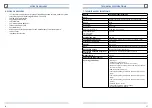
34
35
4
QUICK GUIDE
5
OPTICAL DESIGN
Illustration xx: Rod currently without function.
2
1
Rod without function
At present, the rod (1) on the right-
hand side of the stand base (2) is wit-
hout function.
It is intended for future accessories and
is currently still under development.
NOTE:
As soon as the mod-
el is equipped with an additional
function, you will find information
about it on our website: https://
www.bresser.de.
b) Rod without function (in development)
8
AFTER OBSERVATION: Switch off the microscope
A
Illustration xx A: Switch off the microscope.
Switch off the microscope
Switch the microscope off using the
main power switch ON/OFF (1). To do
this, select position O (OFF).
MAKE SURE
the supplied voltage
matches the instruments
specifications: DC 12 V; 2 A
5. OPTICAL DESIGN: PARALLEL LIGHT (ZOOM TYPE)
NSZ818 is a parallel microscope, using plan apochromatic optical system and can ob-
tain perfect high three-dimensional and visual softer image. Large zoom range and
field of view may be applied to imaging and observation of the image from macro to
micro. It has an 18:1 high zoom ratio, providing superior optical system, high resolu-
tion and ergonomic design.
NA
0.15
W.D.
60 mm
Zoom ratio
18:1
Zoom range
0.75x-13.5x
Total magnification
7.5x-135x
Working distance (W.D.)
60 mm
Field of view (FOV)
Objective
Eyepiece
31.4 mm
23 mm
Long working distance (W.D.) and large field of view (FOV)
Plan Apo 1x objective to provide a working distance (W.D.) of 60 mm. Up 0.15 nume
-
rical aperture (NA) offers you a clarity to study in-depth. The objective`s wide field of
view (FOV) of 31.4 mm enables to see a wider and more comprehensive sample area.
Plan apochromatic 1x objective
The newly developed plan apochromatic 1x objective with a high numerical aperture
of 0.15 is used as the optical system. This ensures a uniform brightness of the field
of view and a clear and reliable image at high magnification in bright field mode as
well as at lowest magnification.
Disconnect main power supply
Disconnect the main power plug (3) from
the power socket (4).
Disconnect the AC adapter (1) of the
power supply from the AC adapter input
terminal (2) on the back of the microsco
-
pe.
Cables and cords are vulner-
able when bent or twisted. Never
subject them to excessive force.
MAKE SURE
that the LED power
ON/OFF switch is set to O (OFF) be-
fore disconnecting the power plug.
2
4
3
5




































